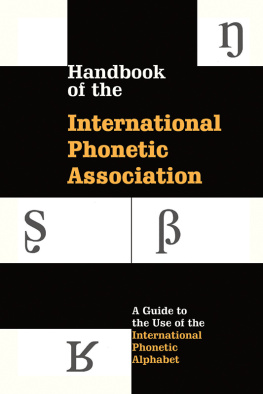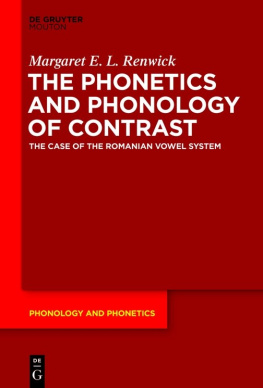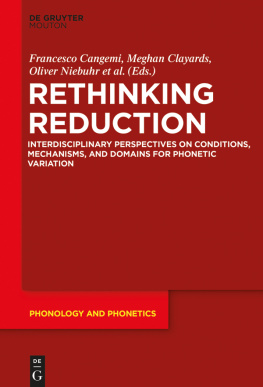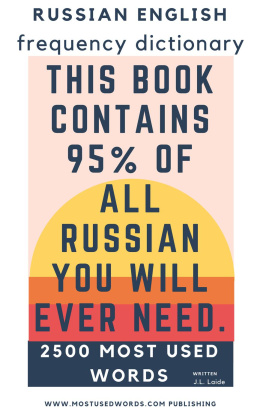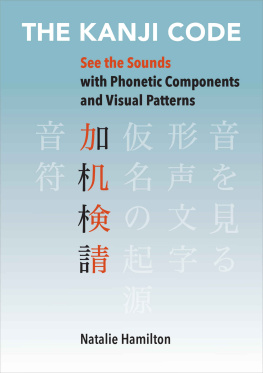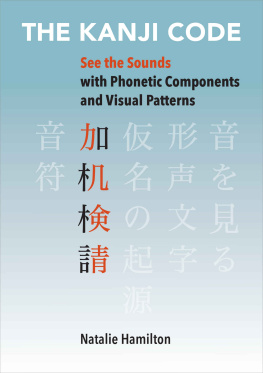The Handbook of the International Phonetic Association is a comprehensive guide to the Associations International Phonetic Alphabet. The aim of the International Phonetic Alphabet is to provide a universally agreed System of notation for the sounds of languages, and for over a Century the Alphabet has been widely used by phoneticians and others concerned with language. The Handbook presents the basics of phonetic analysis so that the principles underlying the Alphabet can be readily understood, and exemplifies the use of each of the phonetic Symbols comprising the Alphabet. The application of the Alphabet is then extensively demonstrated by the inclusion of over two dozen Illustrations -concise analyses of the sound Systems of languages accompanied by a phonetic transcription of a passage of speech. These Illustrations cover languages from all over the world. The Handbook also includes a range of other useful Information. The Extensions to the International Phonetic Alphabet cover speech sounds beyond the sound Systems of languages, such as those with paralinguistic functions and those encountered in pathological speech. A full listing is given of internationally agreed Computer codings for phonetic Symbols, including not only those of the International Phonetic Alphabet but also those of other traditions. And there is extensive information on the history of the International Phonetic Association and its current activities. The Handbook is an essential reference work for all those involved in the analysis of speech.
The International Phonetic Association exists to promote the study of the science of phonetics and the applications of that science. The Association can trace its history back to 1886, and since that time the most widely known aspect of its work has been the International Ahonetic Alphabet. The Handbook has been produced collaboratively by leading phoneticians who have been on the Executive of the Association, and it incorporates (for instance in the case of the Illustrations) material provided by numerous members of the Association world wide.
Handbook of the International Phonetic Association
A guide to the use of the International Phonetic Alphabet

PUBLISHED BY THE PRESS SYNDICATE OF THE UNIVERSITY OF CAMBRIDGE
The Pitt Building, Trumpington Street, Cambridge CB2 1RP, United Kingdom
CAMBRIDGE UNIVERSITY PRESS
The Edinburgh Building, Cambridge CB2 2RU, UK http: www.cup.cam.ac.uk
40 West 20th Street, New York, NY 10011-4211, USA http: www.cup.org
10 Stamford Road, Oakleigh, Melbourne 3166, Australia
Information on this title: www.cambridge.org/9780521652360
The International Phonetic Association 1999
This book is in Copyright. Subject to statutory exception and
to the provisions of relevant collective licensing agreements,
no reproduction of any part may take place without
the written permission of Cambridge University Press.
First published 1999
A catalogue recordfor this book is available from the British Library
ISBN 0 521 65236 7 hardback
ISBN 0 521 63751 1 paperback
Transferred to digital printing 2003
Foreword
The Handbook ofthe International Phonetic Association is a resource containing concise information on the International Phonetic Alphabet and guidance on how to use it - a kind of users manual. It replaces the Principles of the International Phonetic Association, which has been out of print for some time and which had not been revised since 1949. But although the Handbook replaces some of the functions of the old Principles, it is a completely new work with wider objectives.
The old Principles contained a short tutorial on phonetic description, examples of the use of phonetic Symbols, and a large number of specimens consisting of very brief comments on the phonetics of a language and a transcription of the North Wind and the Sun text translated into the language. Additionally, there was some information about the Association, and, printed on the inside Covers, a brief history of it.
The new Handbook broadly speaking retains these components. It is divided into three parts: contains appendices with a variety of reference material.
Beyond the basic similarity of structure, the Handbook is very different from the old Principles. Most superficially, perhaps, it reflects the changes which have been made in that most tangible and widely known product of the Associations work, the IPA Chart. Discussion and exemplification is based on the most recent (1996) edition of the chart. More substantively, the Handbook acknowledges the fact that over the past half Century the advance of techniques for acoustic analysis means that many readers will be familiar with, and quite possibly working with, speech as an acoustic signal. This means it now seems appropriate to use an acoustic display such as a spectrogram not only as a way of presenting one facet of speech, but also to discuss problems which arise in the relation between a segmentally based System of notation and the physical speech event. The Handbook will also contain practical information to do with the use of the IPA on Computers, such as the Computer codes for phonetic Symbols.
The most fundamental differences between the old Principles and the new Handbook perhaps arise from the expectation that the readership of the new work will be much less homogeneous than that envisaged for the old one. The new Handbook is intended to be a reference work not only for language teachers and phoneticians interested in the sounds of different languages, but also for speech technologists, speech pathologists, theoretical phonologists, and others.
This breadth of readership is to be encouraged, given the goal that the International Phonetic Alphabet (hereafter the IPA) should be a Standard for the representation of speech. But it poses particular challenges for the writing of the tutorial sections of the Handbook. The challenges are further increased by the vertical spread of readers from those who are experienced phoneticians to those who know nothing about phonetics. The the fact that there are alternatives in phonological theory is acknowledged. The vertical spread of readers poses the recurring question of how much or how little to say. The lower bound is presumably what a novice needs to pick up in order to have some idea of the principles governing the Organization of the chart. The upper bound is the practical goal of a compact booklet, readily affordable by students, and concise enough to be easily digested by non-specialist readers.
The resulting text in is more discursive than that of the old Principles. It should be borne in mind, however, that it does not attempt the Job either of a phonetics textbook, or of a critique of the IPA. Nowadays there are many good phonetics textbooks available, and it would be expected that students of phonetics would read one or more of these in conjunction with the Handbook. The purpose of the Handbook is not to provide a comprehensive or balanced education in phonetics, but to provide a concise summary of Information needed for getting to grips with the IPA. Likewise, whilst a full-scale critique of the assumptions on which the IPA is founded is perhaps due, the practically-oriented Handbook is not the place for it. The IPA is a working tool for many, and whilst it may be possible to improve that tool, the role of the Handbook is that of an instruction manual for the tool which is currently available.
Next page
